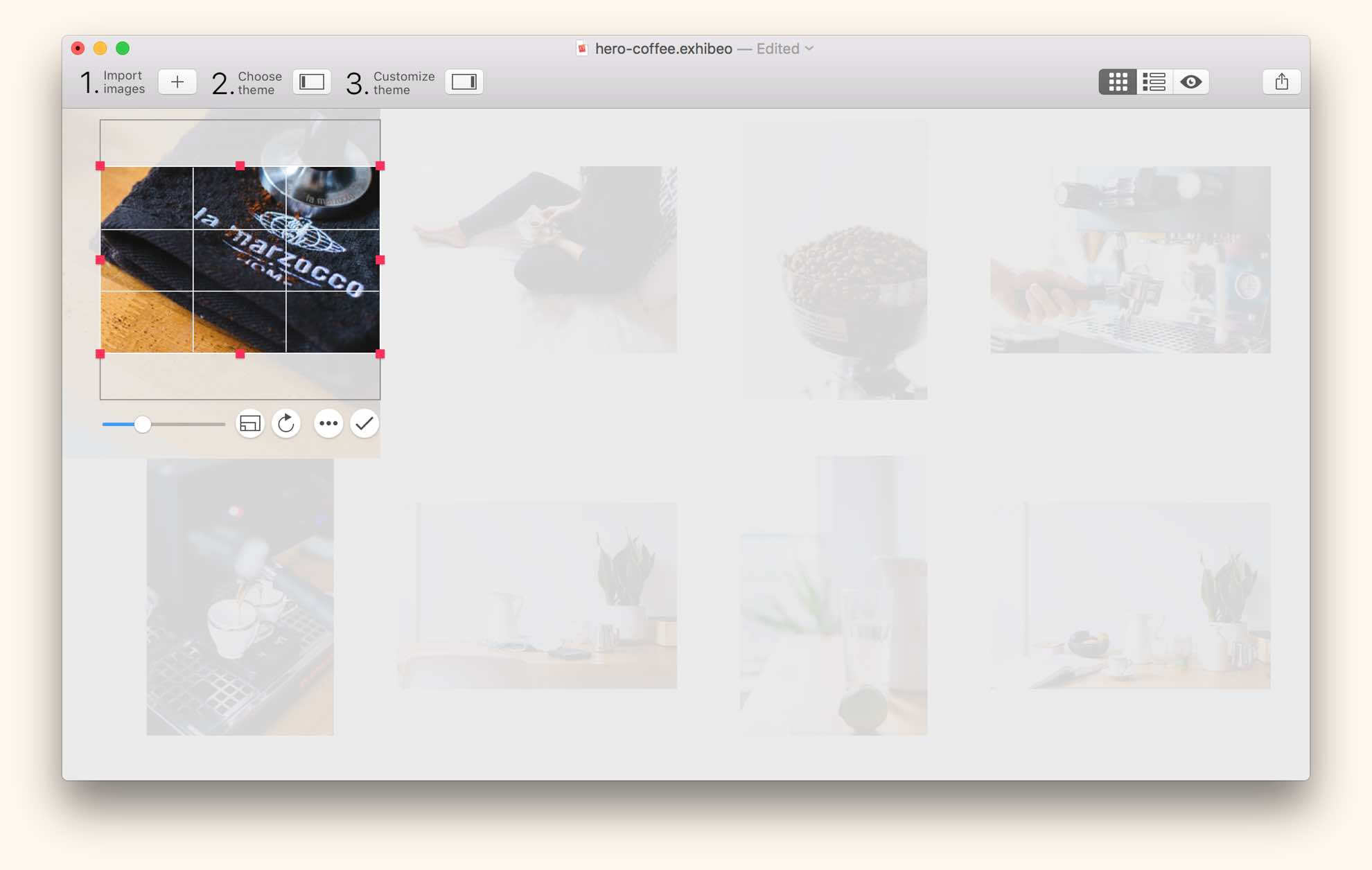Exhibeo 2 Easy To Use Web Gallery App For Mac
Softpress has released Exhibeo 2, an important update to their popular photo gallery and slideshow creation tool for Mac. The updated app is designed exclusively for OS X Yosemite and El Capitan, and offers seven customizable gallery designs; even greater control while editing images and thumbnails; a new “metadata view” for adding image metadata; simplified output code for embedding galleries in websites; and much more.
Exhibeo 2 offers an all-new design, new and updated gallery themes, a new metadata view, and new import options. Exhibeo 2 also streamlines the output code, making it incredibly easy to add galleries to any website.
Exhibeo 2, and Chroma, Softpress’ color palette generation app are both being featured by Apple in the Mac App Store. “We’ve always intended Exhibeo to be a cost-effective, straightforward, yet powerful photo gallery tool and Exhibeo 2 is no different,” said Softpress Managing Director, Joe Billings. “For it to be featured on the App Store is thrilling and a huge achievement for the team.”
Design and build responsive websites, email newsletters, galleries, and color palettes with Freeway, Exhibeo, and Chroma – awesome design software for the Mac. In the Photos app on your Mac, click Photos in the sidebar, then select one or more photos. Tip: To print multiple copies of the same photo on a single page, create as many duplicates of your photo as you need, then select them all before choosing File Print. See Duplicate a photo. Choose File Print. In the print options, select a format.
Exhibeo 2 is available to buy in the Mac App Store.
Photos helps you keep your growing library organized and accessible. Powerful and intuitive editing tools help you perfect your images. Memories displays the best images from your photo library in beautiful collections. And with iCloud Photos, you can keep a lifetime’s worth of photos and videos stored in iCloud and up to date on all of your devices.
Before you begin
- Update your Mac to the latest version of macOS.
- If you use iPhoto or Aperture to manage your photos and videos, upgrade to the Photos app.
Access all of your photos from anywhere
iCloud Photos automatically keeps all your photos in iCloud, so you can access them on your iPhone, iPad, iPod touch, Apple TV, Mac, iCloud.com, or on a PC. When you edit and organize images in the Photos app, your changes are kept up to date and visible everywhere.
Manage your iCloud storage
The photos and videos that you keep in iCloud Photos use your iCloud storage. Before you turn on iCloud Photos, make sure that you have enough space to store your entire collection. You can see how much space you need and then upgrade your storage plan if necessary.
Turn on iCloud Photos
It's easy to get started. Just turn on iCloud Photos in your Settings and make sure that you're signed in with the same Apple ID on all of your devices. On your Mac, go to System Preferences > iCloud and click the Options button next to Photos. Then select iCloud Photos.
Keep your photo library organized
On your Mac, your photo collection is separated into four main categories: Years, Months, Days, and All Photos. The All Photos tab shows all your photos and videos in chronological order. In Years, Months, and Days, you'll find your photos and videos grouped together based on the time and place they were taken.
In the search box, type Character Map, and then, in the list of results, click Character Map. There's still hope though.Basically to view and use those special characters, glyphs etc you need to use your computers character viewer application.In Windows:Open Character Map by clicking the Start button. And believe it or not there's no glyph palette in Photoshop either. There is one in Adobe Illustrator however and it's how I've always accessed those unique special characters. Not everyone has Illustrator though so it can be really frustrating to have just purchased a new font that has tons of awesome special alternate characters to open it up in Elements and not see any of them. Insert special symbols in photoshop cs6 for mac pro.
The Photos app sorts your photos into Memories, Favorites, People, and Places in the sidebar under Library. The sidebar also shows what you and your friends have shared, your photo albums, and projects that you've created.
Learn more about organizing and finding your photos.
Do more with the Photos app
Your Mac is the place that you go to get things done. That’s why the Photos app makes it easier than ever to create a stunning slideshow, share with anyone you like, and quickly find the moment you’re looking for. All with a few clicks.
Play a slideshow or movie
You can prepare a slideshow directly in Photos with a few clicks. Open any album and click Slideshow. Customize the theme and music, then click Play Slideshow.

To play a movie, go to the Months or Days view, click the more button on any collection, then click Play Movie.

You can also view movies in the Memories section. Open a memory, then click the play button . As the movie plays, click the gear button to adjust the movie's mood and length.
Share with friends
Click the share button to share photos in Shared Albums, Mail, and more. Or send photos to your social media accounts, such as Facebook and Twitter.
Search your photos
Find the photo or video you're looking for in no time. Just use the search bar that's built directly into the Photos toolbar. You can search for photos using names of family and friends, locations, or what appears in the photos, like cake or balloons.
Delete photos and videos from your library
If there are photos and videos that you don't want anymore, you can delete one at a time, or several.
 Microsoft OneNote is a free note-taking and syncing app that works on a variety of devices, including Macs. It's not the North Star of note-taking apps, but it squarely takes second place. Microsoft OneNote (for Mac) Microsoft OneNote is a free note-taking and syncing app that works on a variety of devices, including Macs. It's not the North Star of note-taking apps, but it squarely. When it comes to choosing the best note-taking app, there are two clear winners: Microsoft OneNote and Evernote.Both are PCMag Editors' Choices. While the following review of OneNote isn't a head.
Microsoft OneNote is a free note-taking and syncing app that works on a variety of devices, including Macs. It's not the North Star of note-taking apps, but it squarely takes second place. Microsoft OneNote (for Mac) Microsoft OneNote is a free note-taking and syncing app that works on a variety of devices, including Macs. It's not the North Star of note-taking apps, but it squarely. When it comes to choosing the best note-taking app, there are two clear winners: Microsoft OneNote and Evernote.Both are PCMag Editors' Choices. While the following review of OneNote isn't a head.
Delete one photo
- Select the photo that you want to delete.
- Press the Delete key.
- Confirm that you want to delete the photo.
Delete multiple photos
- Press and hold the Command key.
- Select the photos that you want to delete.
- Press the Delete key.
- Confirm that you want to delete the photos.
When you delete a photo, it goes into your Recently Deleted album, where it stays for 30 days. If you use iCloud Photos, the photos that you delete are moved into the Recently Deleted album on your other devices too. After 30 days, Photos deletes the photos permanently. You can permanently delete photos right away when you click Delete All in the Recently Deleted album.
When you delete photos directly from an album by pressing the Delete key, you only remove them from the album and not your entire photo collection. If you want to delete photos from both the album and your collection, press Command-Delete.
Edit your photos
Photos includes powerful, easy-to-use editing tools. You can apply adjustments to your photos and make them look exactly the way you like. Then if you want to start over, you can always revert to the original photo. Here's how to get started:
- From the Photos view, or from within an album, double-click the photo you want to edit.
- Click Edit in the upper-right corner of Photos.
- The editing tools appear along the right side of the window. Click the tool you'd like to use.
After you edit your photo, click Done. Want to start over? Click Revert to Original. If you use iCloud Photos, you'll see the changes on all of your devices.
With Photos for macOS High Sierra and later, you can also send a photo to most third-party photo apps for editing, then save the changes right back into your library. Learn more about editing your photos with third-party apps and extensions.
See and add information about a photo
You can also add details to your photos, like a description, keywords, or a specific location. You can even Add Faces to name your friends and family in each photo.
To view the Info window, double-click a photo to open it and then click the information button in the upper-right corner, or select a photo and use the keyboard shortcut Command-I. Once you add information, you can use the Search bar to find photos by keyword, title, description, faces, or location.